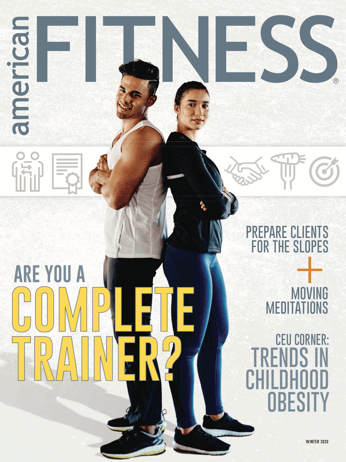Originally published in the Winter 2020 issue of American Fitness Magazine.
“Without objective information to work from, coaching a client to better health and wellness is like throwing darts blindfolded and hoping one will eventually hit a bull’s-eye,” says Andrew Payne, MS, NASM-CPT, CES, PES, CNC, an Arizona-based fitness education expert who helped write the course content for the NASM Certified Nutrition Coach (CNC) program.
That’s why a nutritional assessment should be a key component of the initial client meeting. “A nutritional assessment serves the same purpose as a fitness assessment,” says Payne.
 “By gaining an understanding of how they are currently eating, [clients are] empowered with objective, personalized, foundational knowledge that significantly boosts readiness to make necessary changes.”
“By gaining an understanding of how they are currently eating, [clients are] empowered with objective, personalized, foundational knowledge that significantly boosts readiness to make necessary changes.”
To help with this, the new NASM-CNC program provides guidelines and tips for assessing dietary intake. One of the simplest methods—24-hour recall—involves interviewing clients to help them remember what they recently consumed. This method is adapted from the National Health and Nutrition Examination Survey (NHANES) dietary interviewer procedures manual, which recommends having clients start by making a “quick list” of food and drink without going into detail. Then, to help them remember specifics more fully, the fitness coach asks follow-up questions like these:
- Are there any food categories you may have forgotten (beverages, sweets/desserts, snacks, condiments)? (This is asked once more at the end of the interview, too.)
- What activities did you do throughout the day? (This may bring to mind other calories consumed—e.g., while snacking at a meeting or in the car.)
- For each food item: Where did you obtain it (home, restaurant, vending machine, etc.), what brand was it, how was it prepared, how was it served (alone or as part of a meal), and how much of it did you consume?
The CNC materials offer additional insights, too. For example, the manual suggests reminding clients that you are not judging them but trying to help them, so they should not attempt to look “healthier” than they are.
Payne recommends having clients spend a week tracking daily intake, writing down foods as they eat them so they won’t forget key details. (The CNC provides several printable templates.)
“Putting pen to paper for every meal and snack can understandably become tedious, which is why I say to do it only for 1 week,” says Payne. “That way, both workday and weekend habits are brought to light, and coaching sessions with clients can [focus on] objective measures that they can build new life patterns around.”
Interested in becoming a Certified Nutrition Coach? Learn more about the CNC program.
















